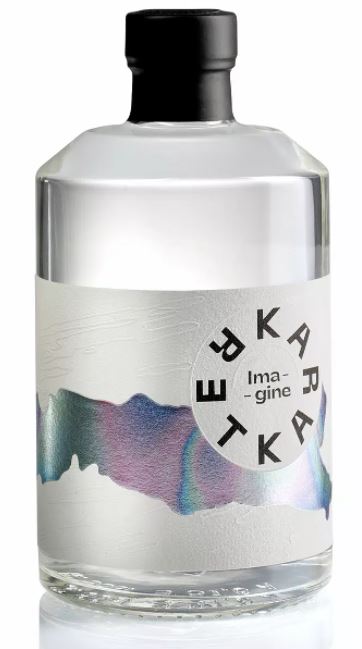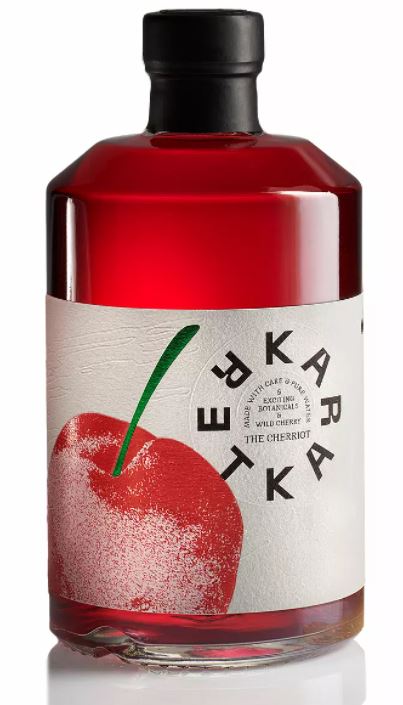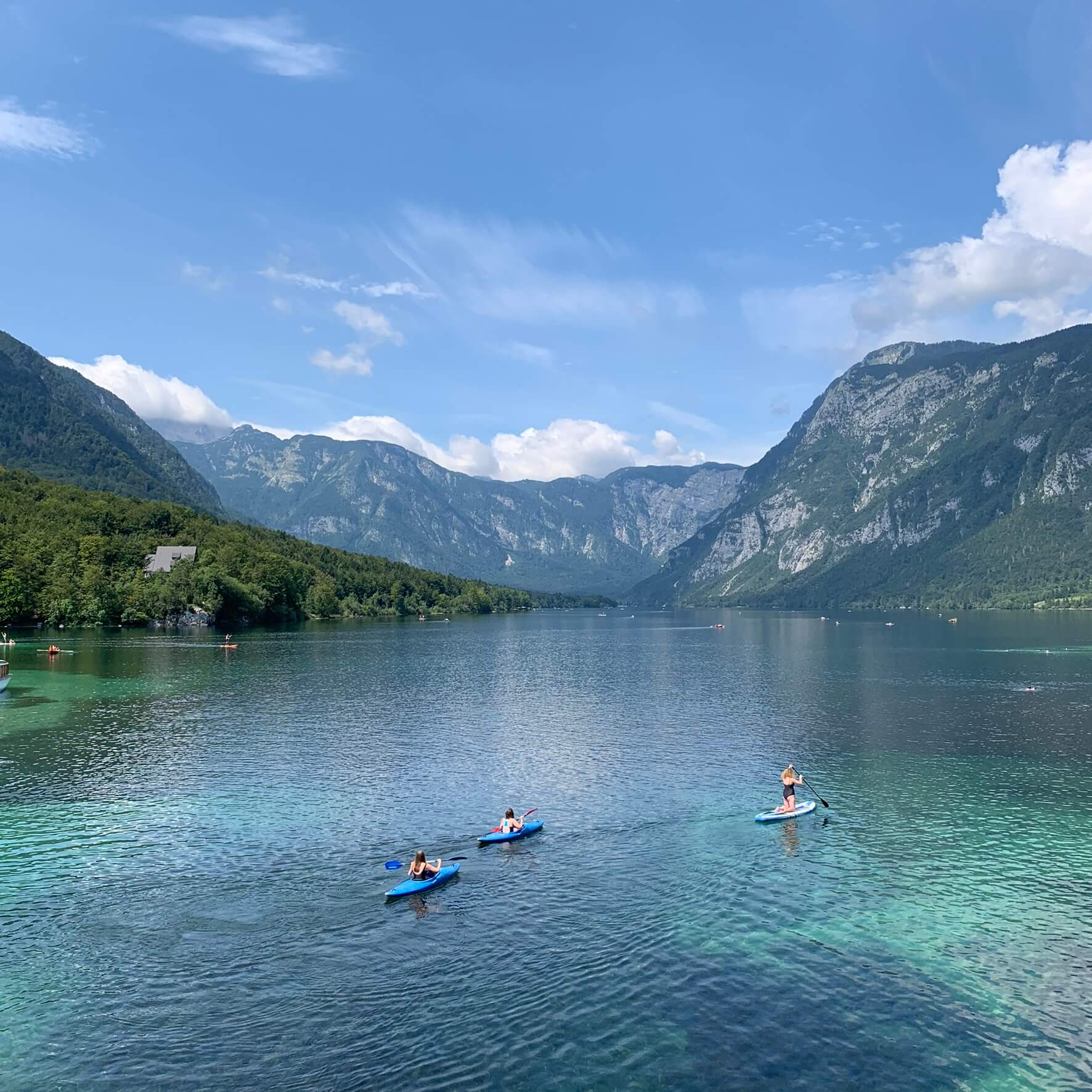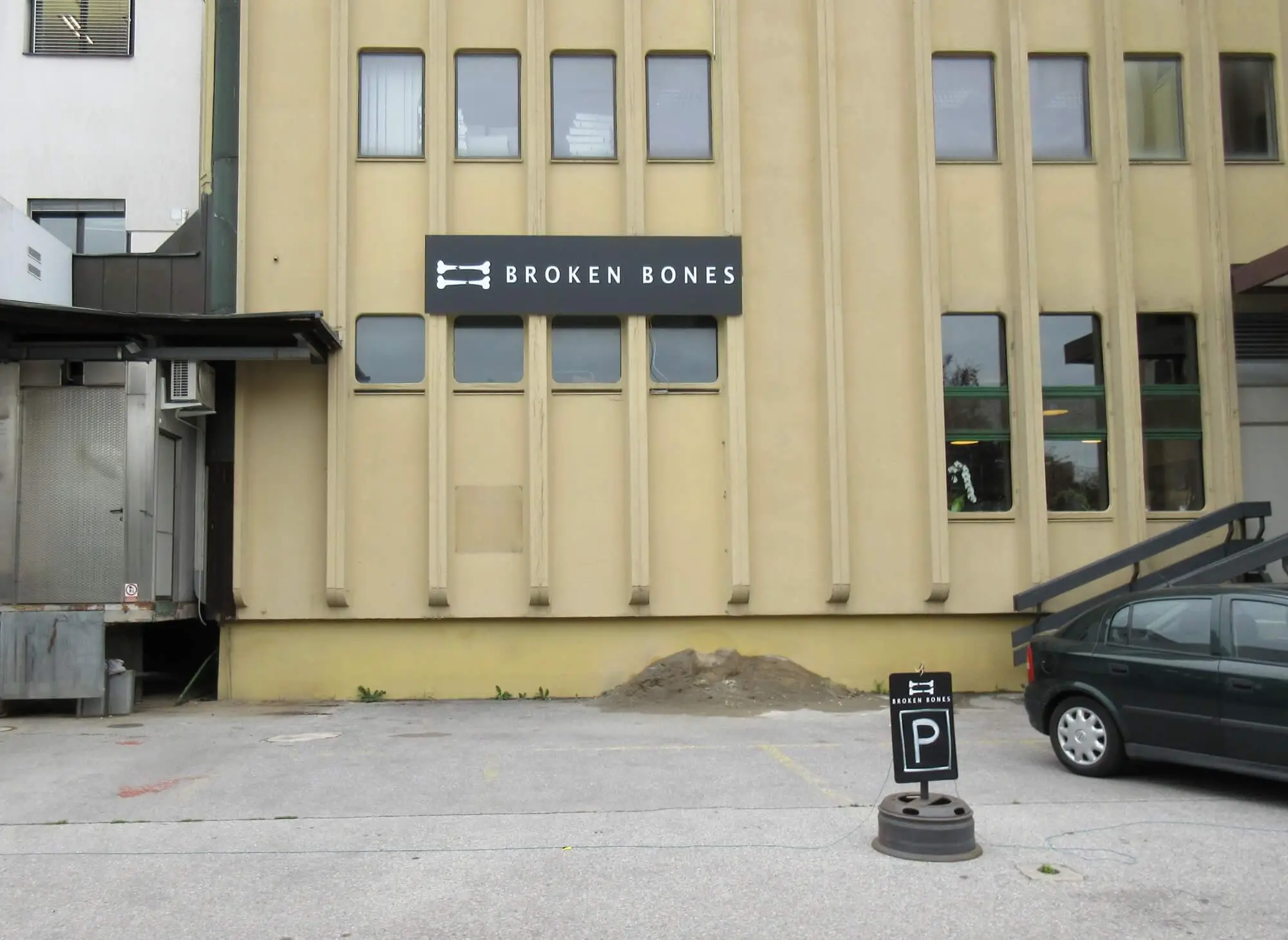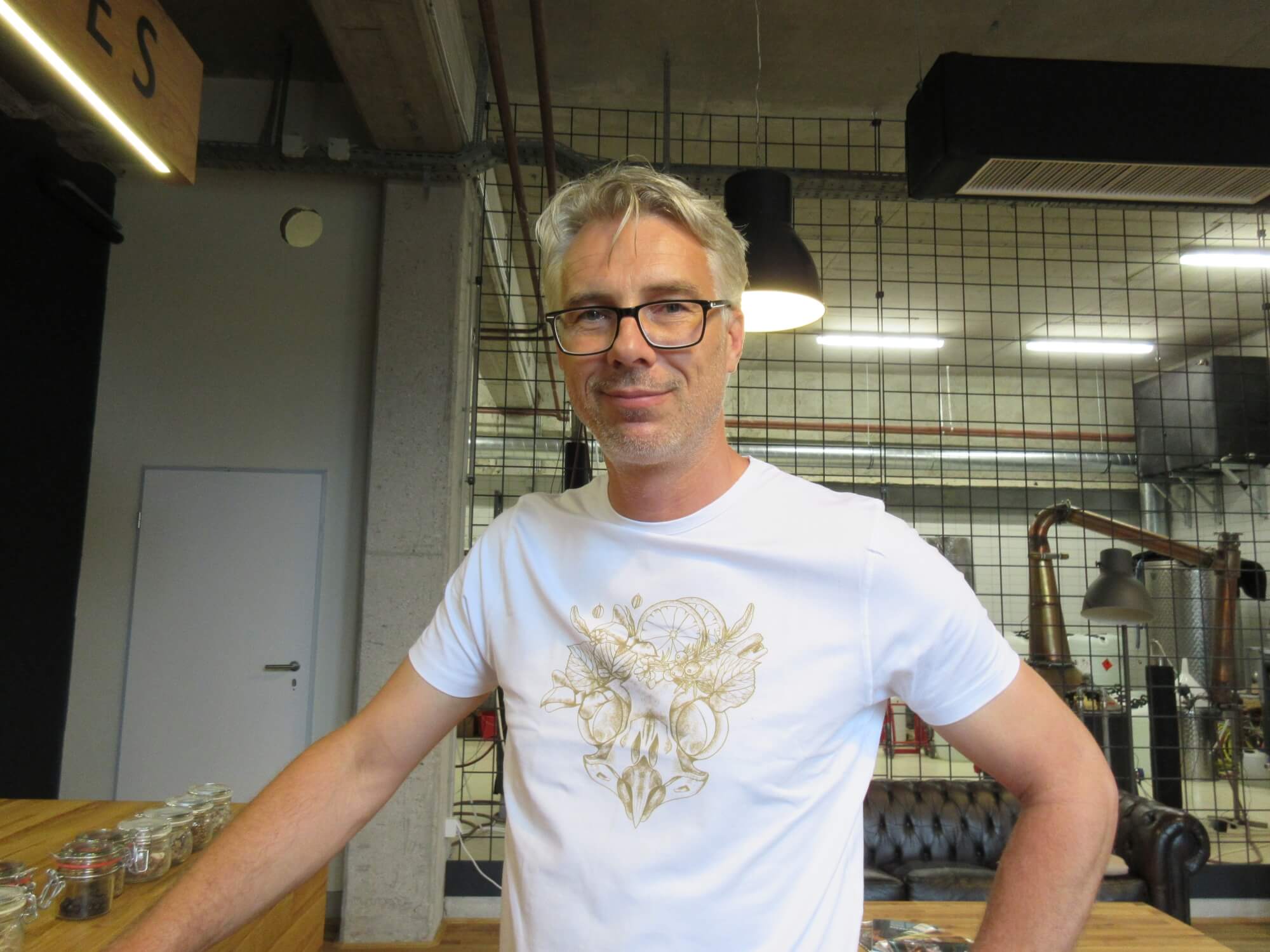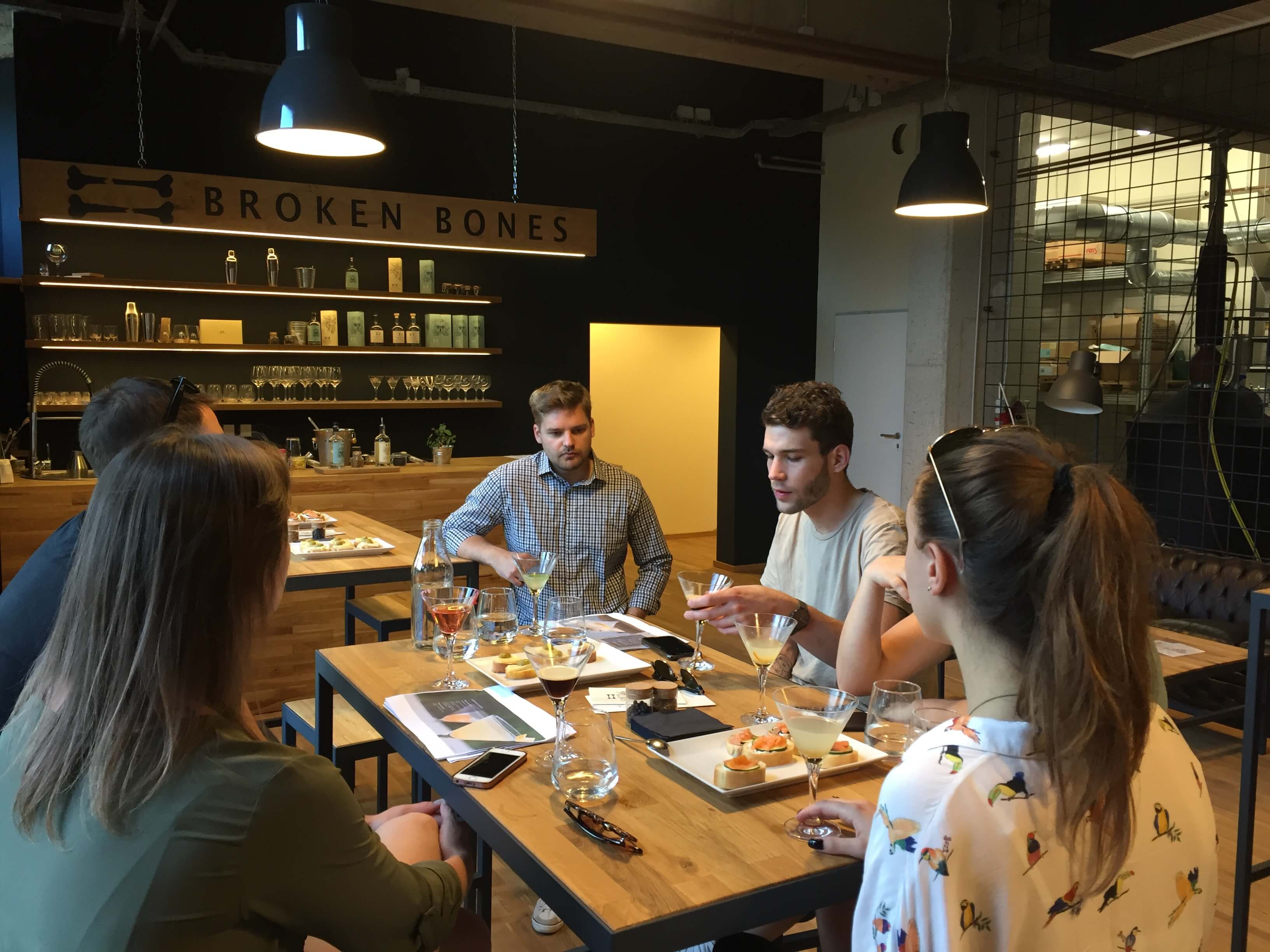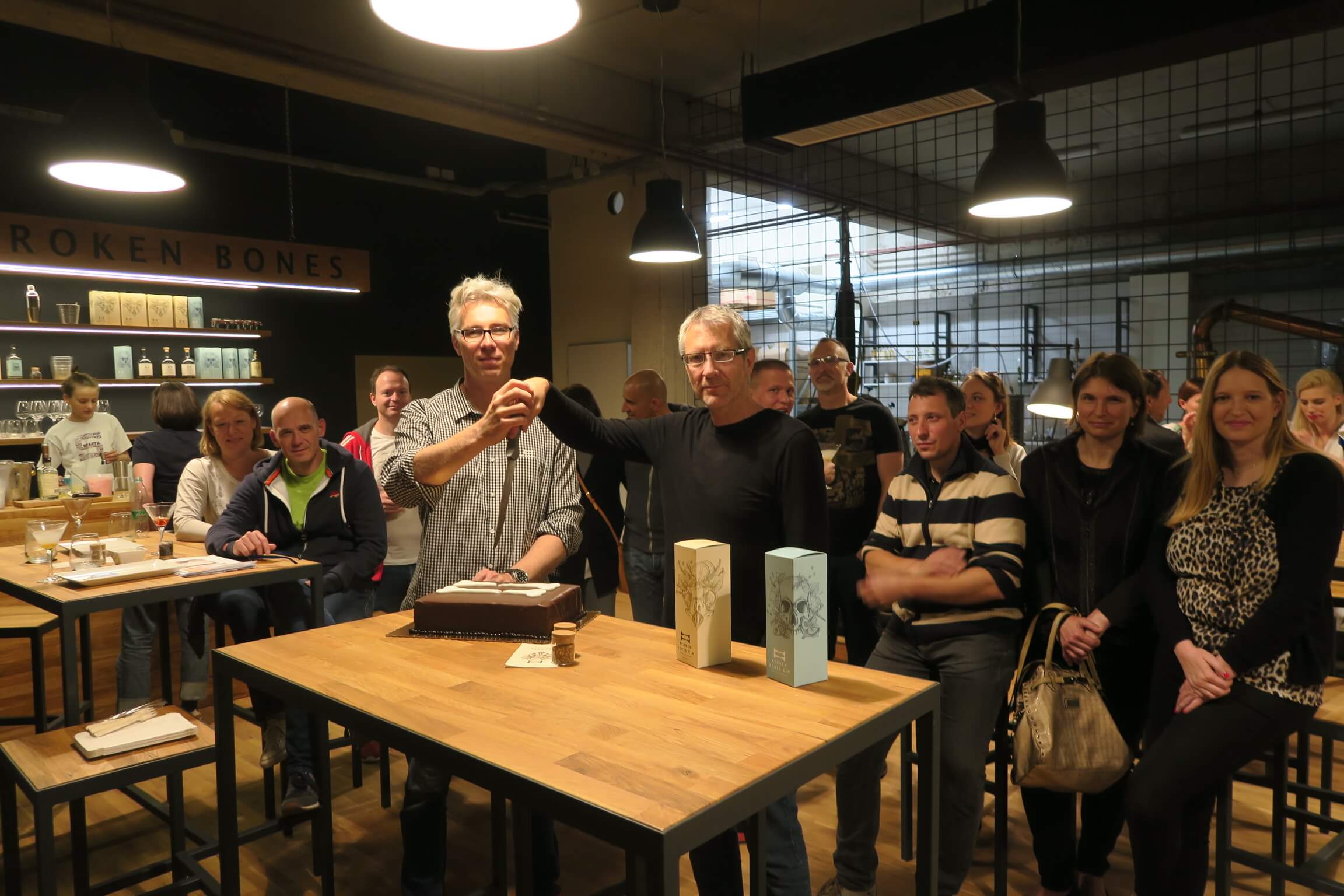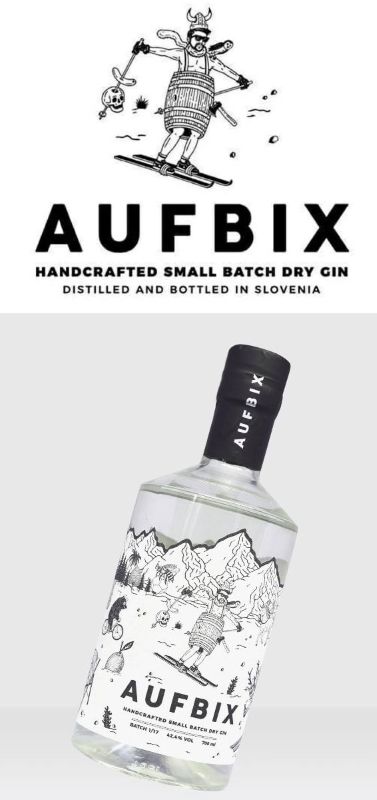Ljubljana related
Things are finally, slowly opening up again, and one event on the horizon is the Brin Gin Festival, to be held on the 2 and 3 July (2021) in Dutovlje – although check in on Facebook to keep up with developments.
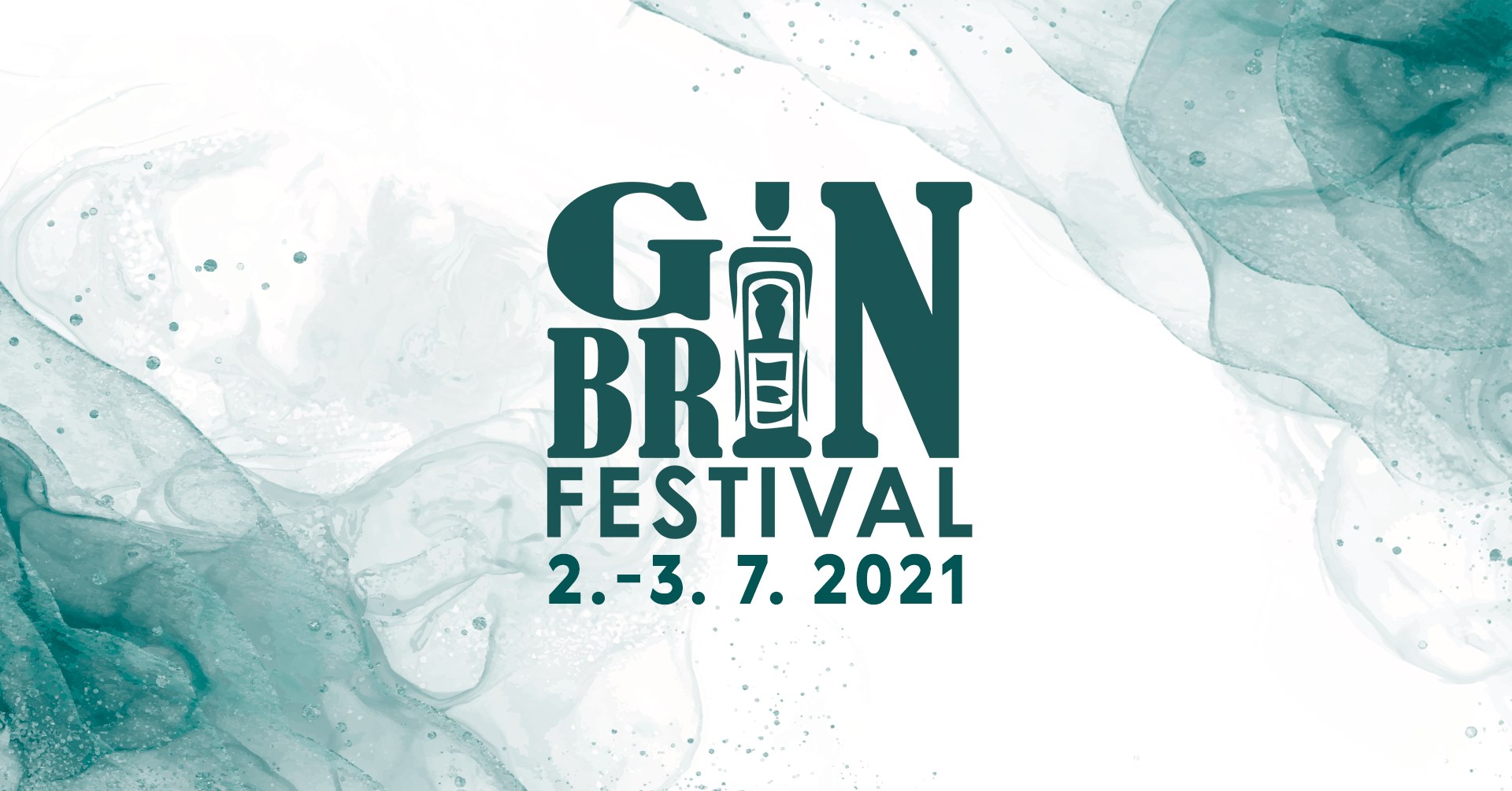
The promise of this event, along with the reopening of bars, is a good excuse to check back with one of Slovenia’s more interesting gin producers, Karakter. We first met the team behind the distillery at Brin 2019, in a long, hot afternoon of sampling food and drink. And to be honest, after your fifth or sixth gin things do tend to become something of a blur, and even a dedicated professional, armed with a pen, notebook and press card to ensure continued access to free booze may think about calling it a day and faking a report. I overcame such doubts, however, and continued my research for the sake of our readers until ending up at what I think was my last stall of the event, Karakter’s. There I heard the story of the handcrafted gin they’d been making in Bohinj, and enjoyed the revelation that is their Cherriot gin, infused with wild cherry and a charming pink, even picking up a bottle, possibly two, to continue my work home.
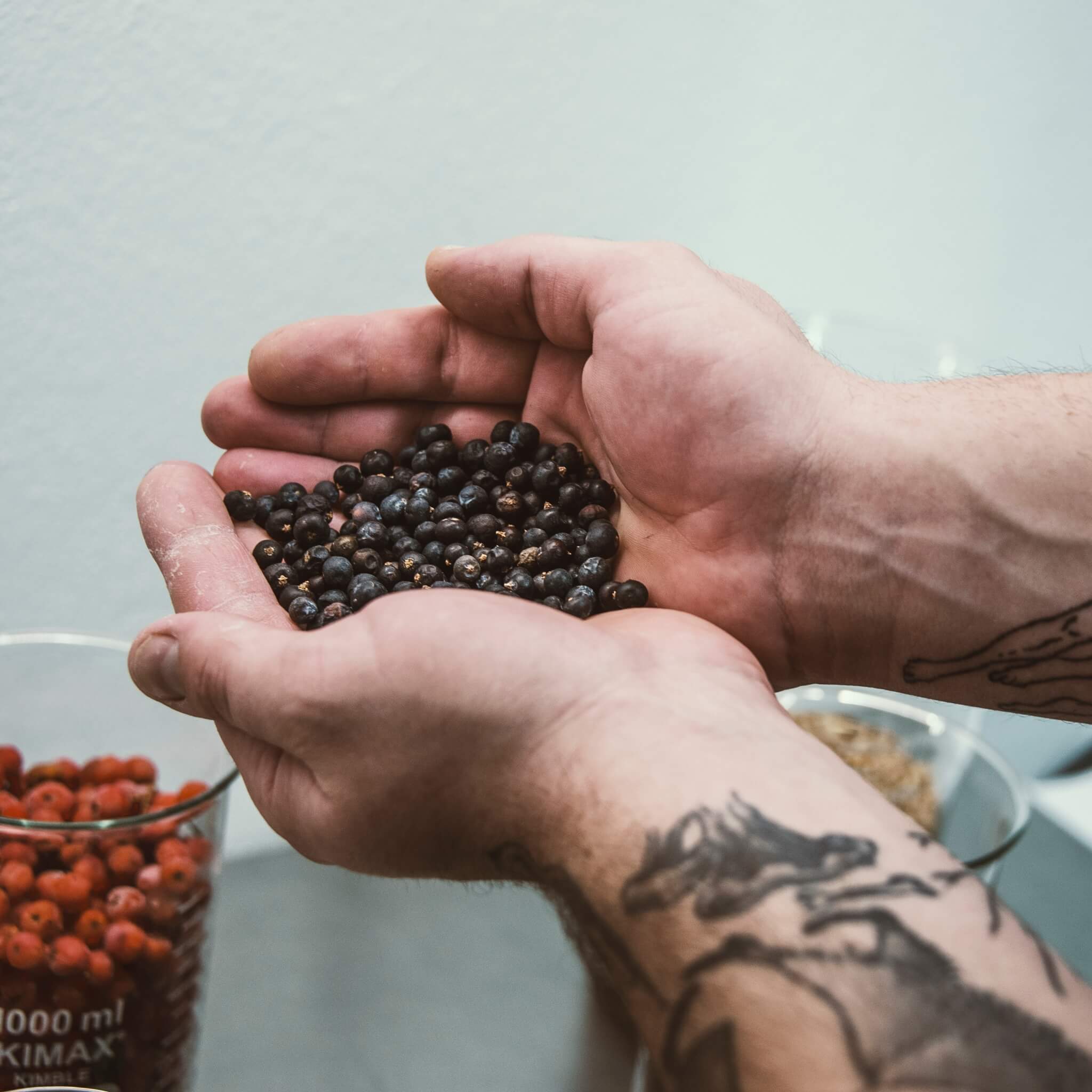
Juniper berries (Slo. brin), a key ingredient in gin, have a long tradition of cultivation and use in Slovenia, most famously in the spirit brinovec
Waking up the next mid-day with a sore head and surrounded by evidence of personal failings and gross indulgence, high and low, I swore off alcohol for some time, but did eventually return to that bottle of cherry gin and enjoy it. And the other day, almost two years later and with bars reopening, the summer soon upon us, I finally got around to contacting Karakter again, to find out what I’d forgotten.
Note that the following interview with Urban Bajrič – who together with Matic Bezjak and Timi Rožič is behind the various projects – was conducted under covid-secure conditions – at a distance, and with all participants disinfected with gin.
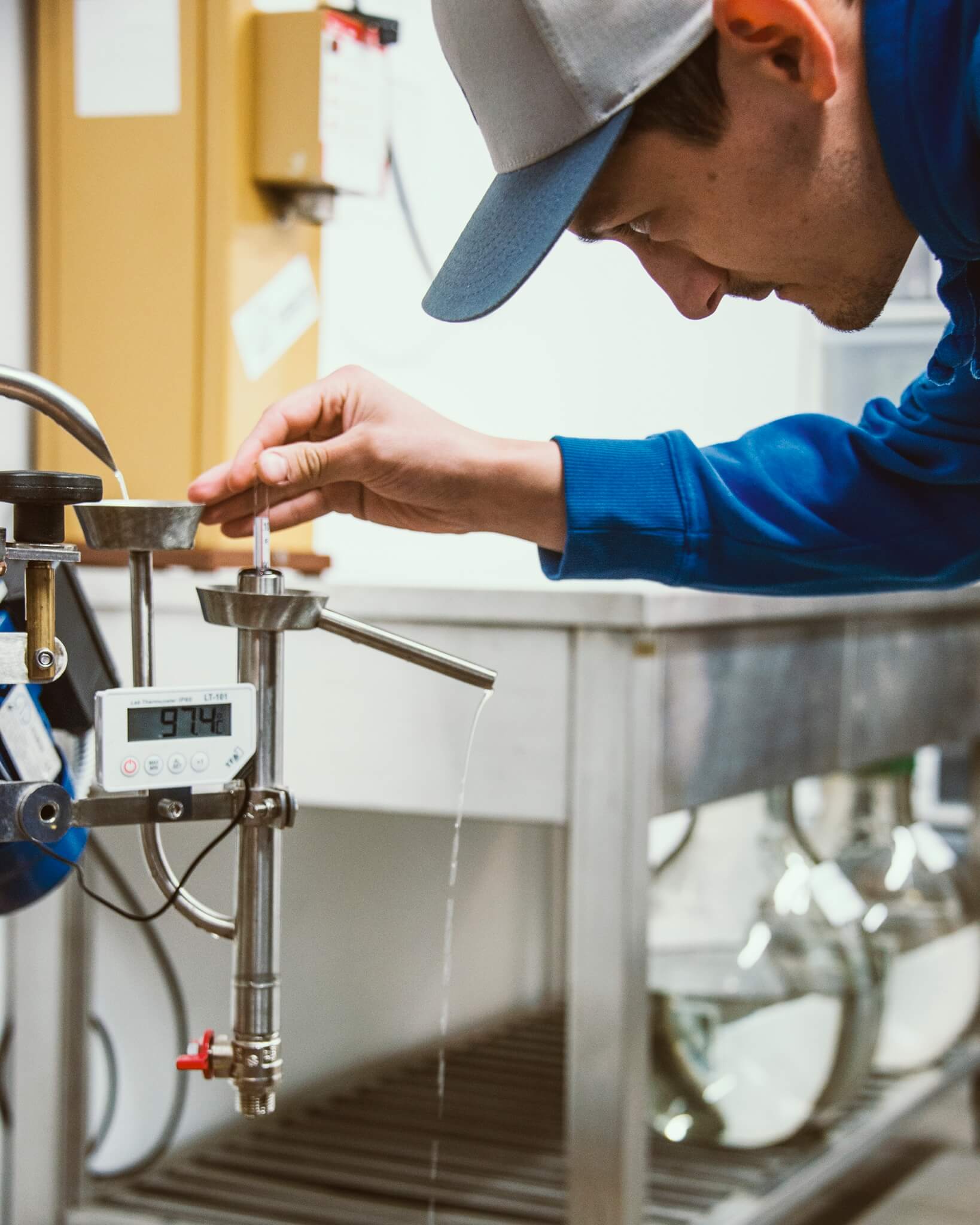
Urban, making gin
How did you get into making gin?
At first in 2016 we started homebrewing beer, and we liked playing with different aromas, flavours, infusions, etc. After brewing quite a few batches of beer we thought about setting up a business, but at that time, there were already many breweries. So we made some research and decided we would try our luck with distilling. We opened up our business in February 2018. After our first two products, which were gin, we got a chance to take over Karakter Bar, called Paviljon at that time, and we did. A year after that, we started Zanoodle, an Asian bistro in centre of Ljubljana. Now, after everything that’s happened in the last year, I think it is time for us to go back to our roots and focus on distilling and fermenting again.
What gins can people try now?
We have two gins at the moment, Imagine and Cherriot.
Imagine Dry Gin, which we used to sell under the name Karakter Gin, is a London Dry type, but not a classical juniper heavy gin, instead it’s very fruity, balanced and fresh. It’s made with 25 botanicals used in total, the traditional and red & black currant berries, along with cranberries, kaffir lime leaves, wild thyme, rose petals, mountain pine and some others we’ll keep a secret for now. On the technical side we use all three ways of preparing the botanicals, percolation, infusion, and extraction, with the distillation taking place using a 100-litre column still. We’re based in Bohinj, and we wanted this gin to reflect that, so some of the botanicals are picked locally, such as wild thyme and mountain pine. We use 8.5 kg of botanicals per 100-litre batch, and 6 kg of that are fresh berries, with this freshness making it into the gin through the slow distilling process and generous cuts, using the foreshots and tails. We’re very proud of this gin, and especially since it won a bronze medal in the New Western style gin at the Craft Spirits Berlin Awards for 2021, the world’s largest competition for handmade craft spirits.
The other gin have now is the Cherriot Infused Gin that you tried before. That’s made with a total of 17 botanicals, the traditional ones plus things like beetroot, almonds, dry pears, and raspberries. Then After distilling that’s infused with wild cherry and hibiscus flowers, As with Imagine, we get the full flavour from the botanicals by using percolation, infusion, and extraction. The result is aroma that’s like a sweet gin, although no sugar or other sweeteners are added, it’s all from the natural ingredients.
So right now we have a traditional gin, with the feeling of Bohinj, and a sweeter, cherry gin, both of which are ideal for drinking neat or with a mixer.
Lake Bohinj - not a bad place to be
You mentioned Bohinj and how it inspired your Imagine gin. What’s it like working there? work?
Bohinj is a special place, everyone knows each other and sometimes people know more about you than you do. Wherever you go you have to drive for at least 30 minutes, and whatever you do, there are a thousand eyes staring at you. Just like any small, isolated community I guess.
But if you can look past some minor setbacks, Bohinj is a fantastic place to live and work. Of course it’s easier to run a business in Ljubljana, but if I had to start the distillery again, with the knowledge I have now, I’d still choose Bohinj. I love it.

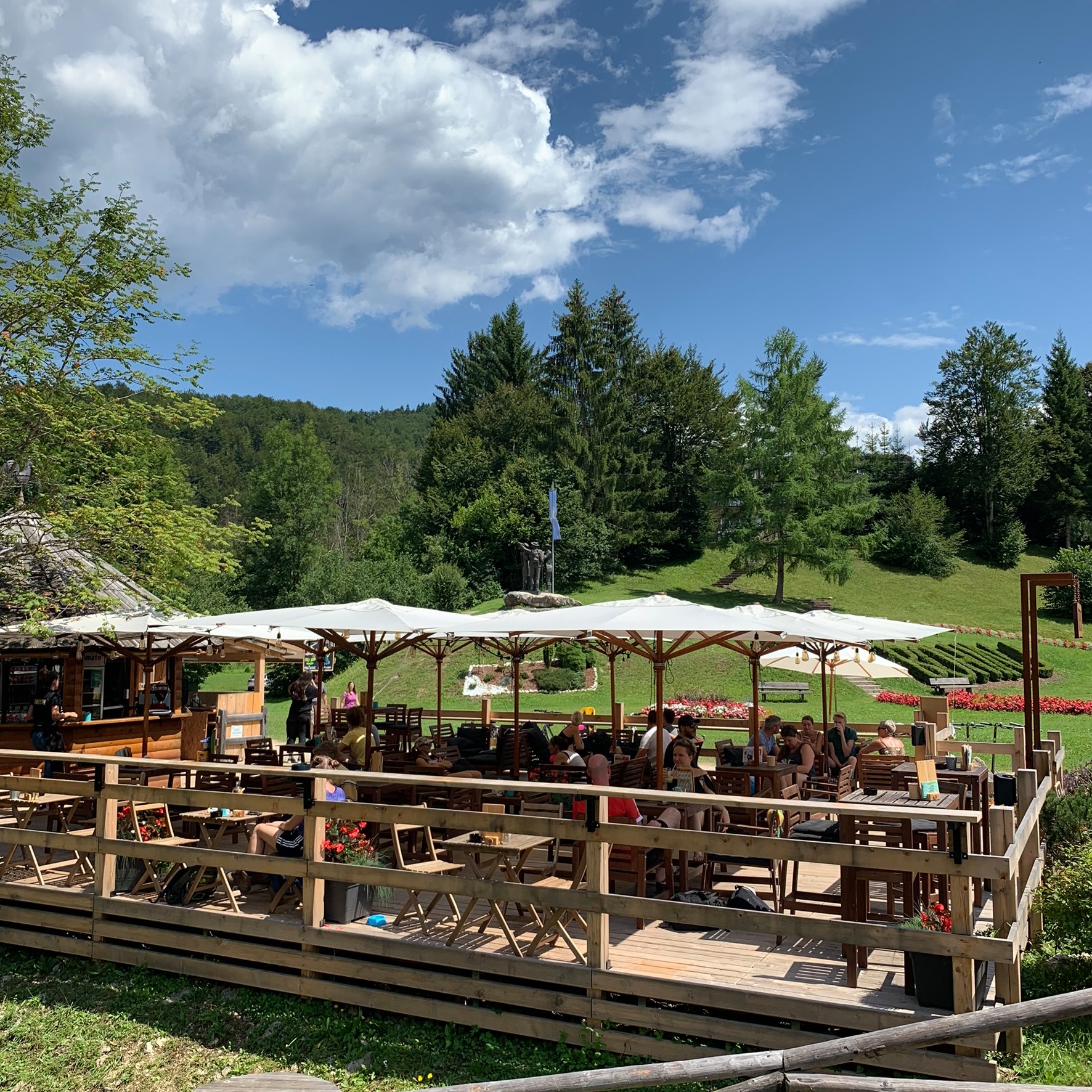

Karakter Bar, by day...
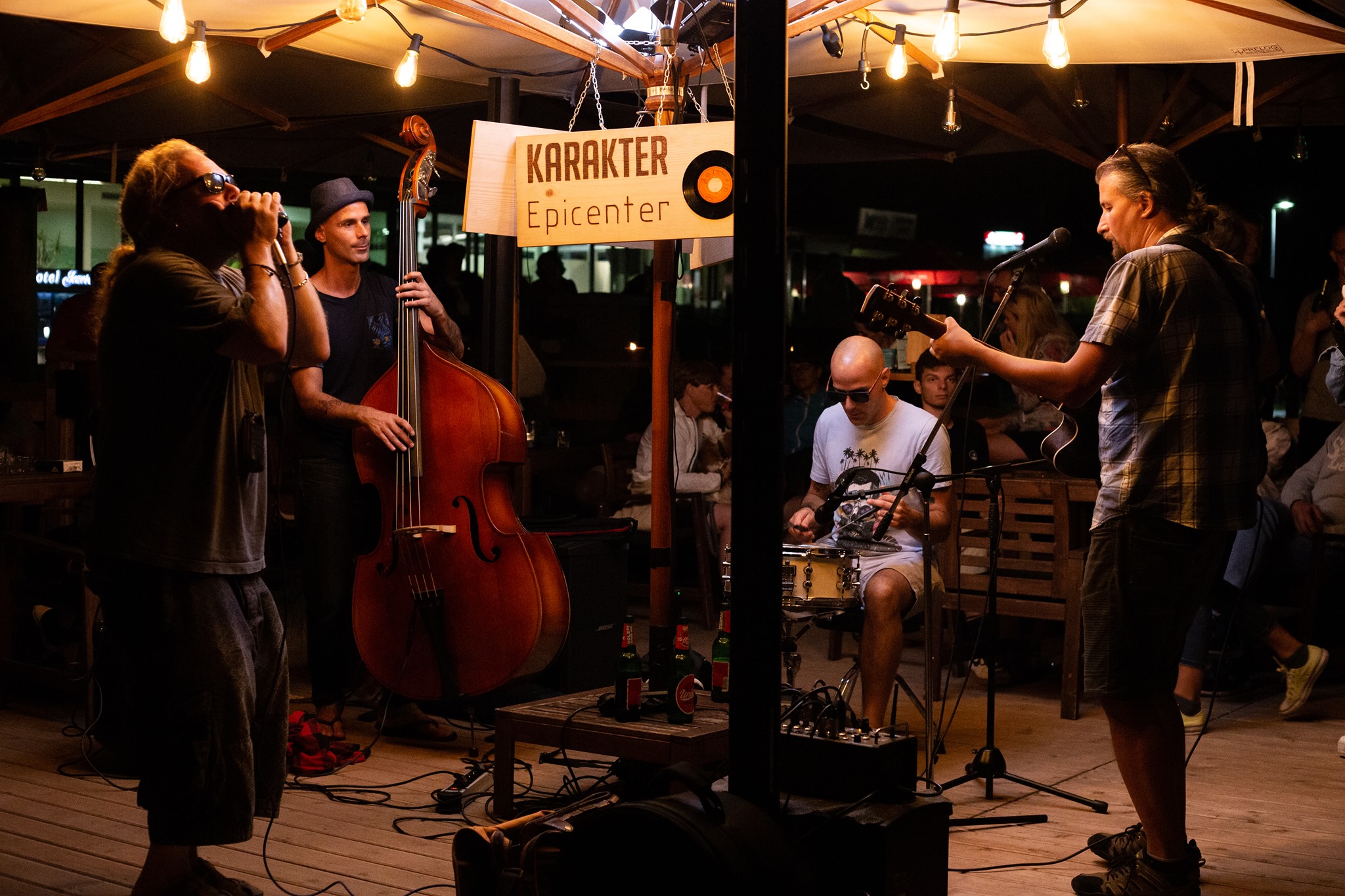
...and night
In addition to gin, you also have the Karkater Bar, Zanoodle Bistro & Shop – can you tell us something about those?
Sure, Karakter Bar (opposite Hotel Jezero - Ribčev laz v Bohinju, 4265 Bohinj Jezero) is a place to relax, enjoy a cool gin and tonic and live music on a warm summer evening. Before COVID there was a lot going on, and with any luck there will be again soon, with live concerts from Slovenian jazz, folk and pop artists, culinary events in collaboration with local chefs, along with children’s events, weekend barbecues, and so on.
ZANOODLE is a Slovenian-Asian fusion bistro in Ljubljana not far from Križanke (Rimska cesta 21, 1000 Ljubljana) with an ever-changing menu that includes everything from soups with homemade noodles, to dry aged beef, seafood, desserts and burgers.
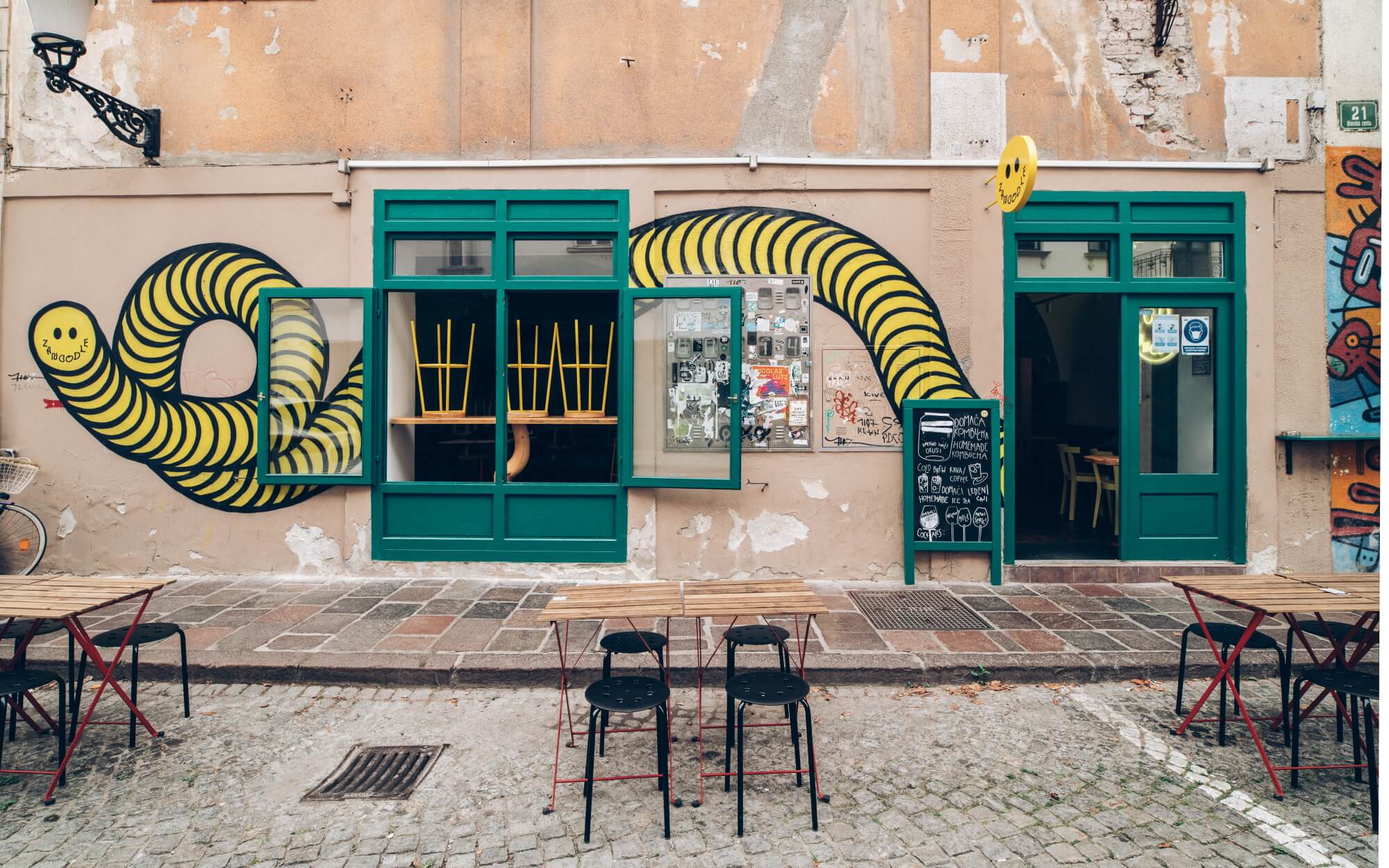
Zanoodle outside...
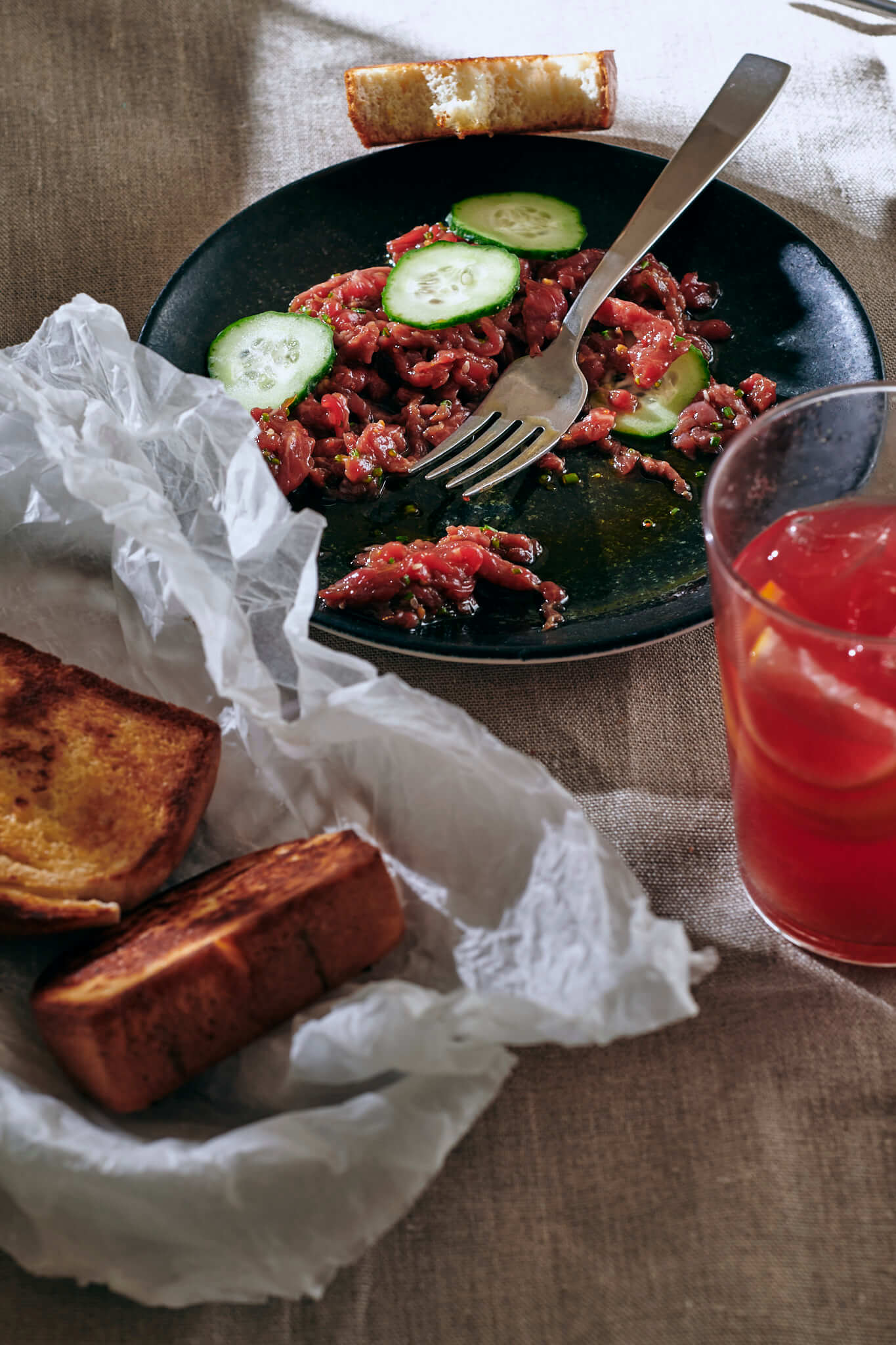
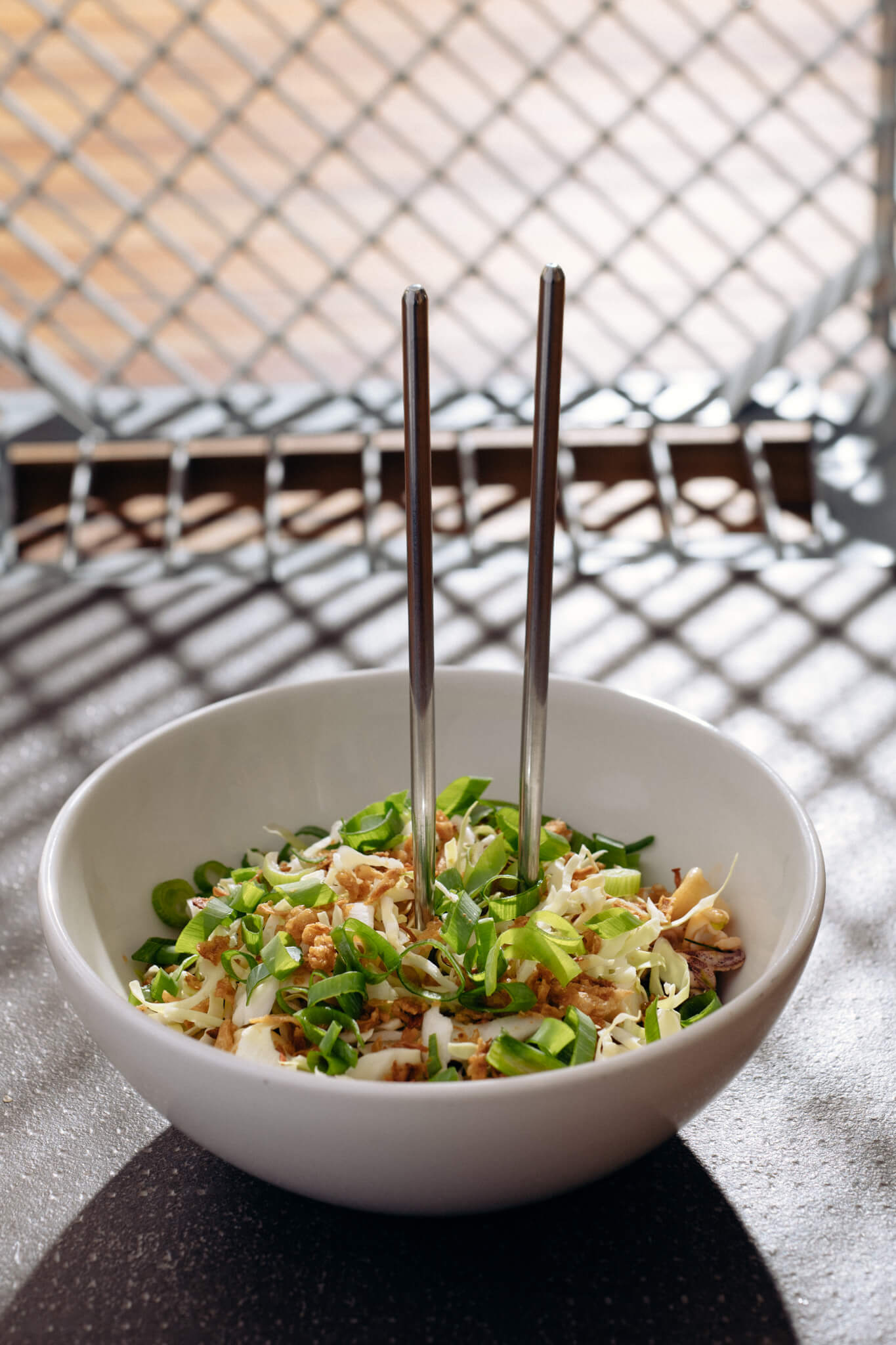
...and in
Can people visit the distillery of they go to Bohinj?
We don’t offer guided distillery tours as a service, but we’re very happy to show people around the distillery when they come and buy a bottle of gin. That kind of ‘tour’ can take up to eight people, and we can walk you through the process from start to finish. The main reason people like to visit and see the distillery is because we don’t hide anything, we’re happy to explain everything about our gin and the production process. This kind of knowledge-sharing and openness is important – for us, the customers and the business. Our process and our ingredients are 100% natural, so we have nothing to hide.
How did COVID affect your work?
To be honest, a lot. We depend on bars and restaurants, and these were closed or had very strict limitations for more than eight months, and that really hit the demand for gin. That said, the situation is now improving and we’re optimistic and hope that everything can get back to normal as soon as possible, that Slovenia can enjoy the summer. When things do reopen we want to encourage people to support their local businesses in these challenging times. Every order you make at a small hospitality business – a restaurant, café or bar – makes a difference and helps them to recover, and with it the local community.
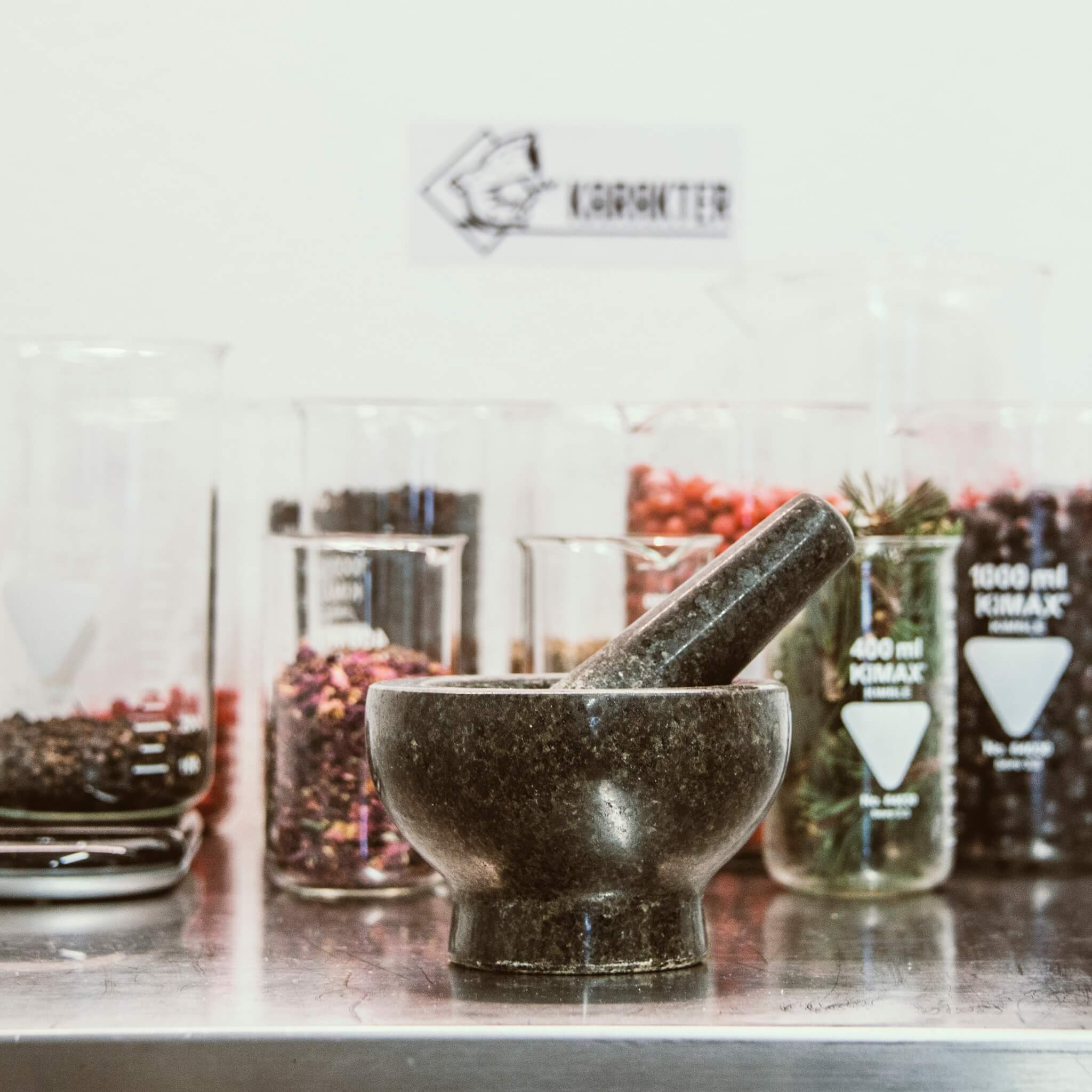
What do have planned next?
There is a brand new product coming in June 2021, with the Brin Gin Festival in July being the first official event where everyone can try it. What we can say is that we are developing experimental fruit brandies that will be available in limited quantities – coming later this year.
Where to find Brin Gin Festival
Where can people try and buy your gin?
A list of locations is available on our Instagram account (we are still working on our website to highlight locations). For a perfect gin and tonic, head to Zanoodle in Ljubljana or Karakter Bar in Bohinj. Bottle purchase is possible in many local shops in Slovenia and of course through our website, with shipping throughout Europe.
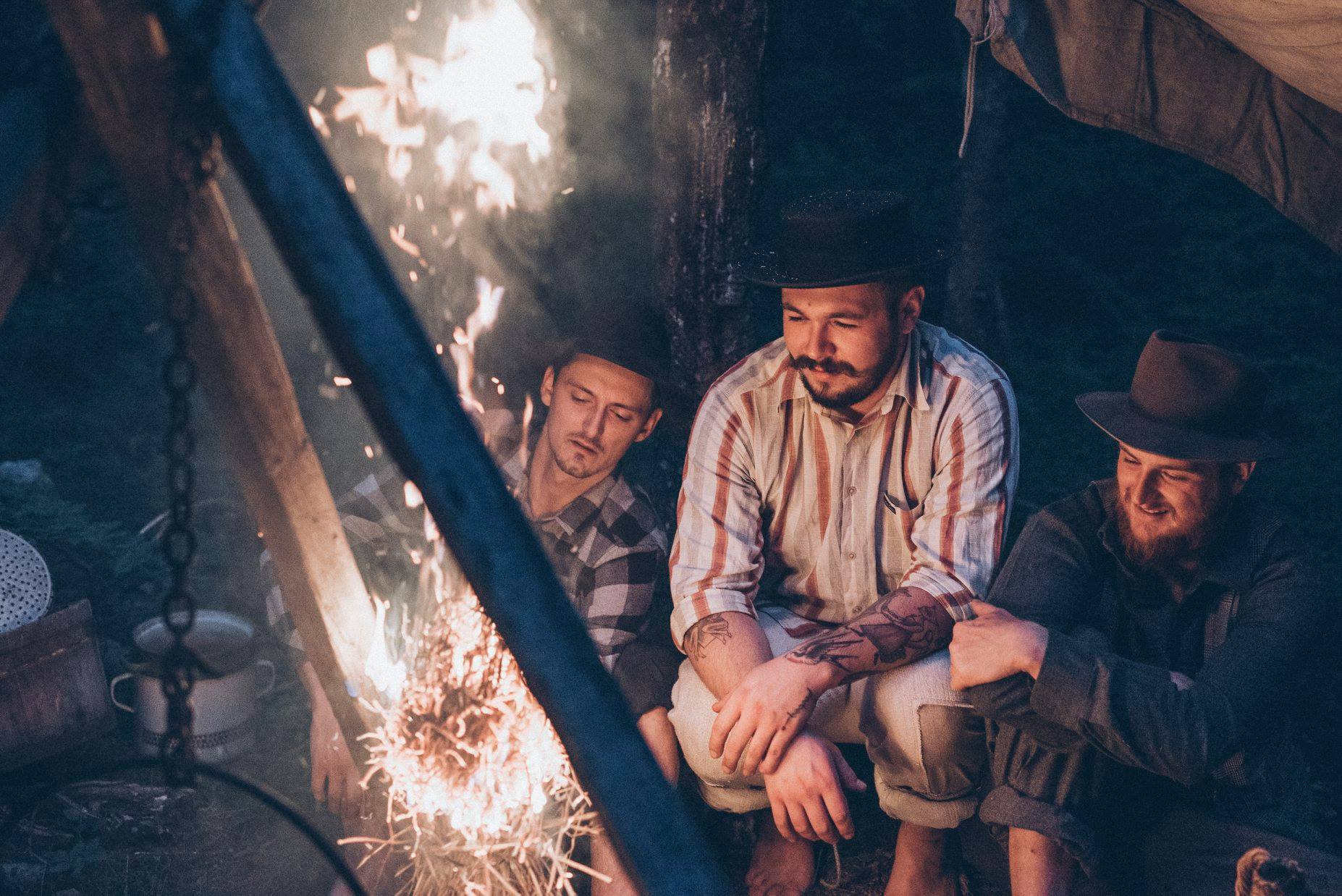
Slovenia has a long tradition of growing juniper berries (brina) and turning them into alcohol (brinjevec or brinavec), and thus the rise of Slovenian gin producers over the last few years isn’t as surprising as you might think. Moreover, the relatively small scale and rapid production that gin enables, unlike, say, wine, means it’s an interest open to the hobbyist, craftsperson and entrepreneur alike – ripe for exploration and adventure.
Photo: Open Kitchen, to promote the same group's Brina Gin Festival
In addition to the growing number of Slovenian brands, many following their own paths in terms of flavour and production methods, there are also events like the Brina Gin Festival, drawing more attention to the industry, serving new cocktails and food pairings, enabling drinkers to meet producers, and vice versa.
One fruit of this raised profile is the news this week that Ljubljana’s Broken Bones Distillery has won awards in the Contemporary Gin Category (Over 42% ABV) and London Dry Gin Category at The Gin Guide Awards 2020, with the firm’s Broken Bones London Dry Gin also named the Best in Europe (including, it must be said, Britain).
Broken Bones Distillery is in a quiet building on the edge of Ljubljana. Photo: JL Flanner
Gins from more than 30 countries competed in The Gin Guide Awards 2020 in categories based on production methods, style of gin, and country of production. The winners were selected through a rigorous blind tasting process conducted by a large panel of distinguished gin experts, distillers, retailers and mixologists. Each gin’s appearance, aroma, flavour, mouthfeel, finish and overall quality and market appeal are judged to decide the highest scoring gins, based purely on the spirit itself and with no influence, the Awards stress, from branding or marketing.
The full list of winners in all categories can be found here, while you can learn more about Broken Bones Distillery, including how it got its name and how you can pay a visit, in our interview with one of the owners, Boštjan Marušič, from last year. You can also visit the Broken Bones website and order a bottle of London Dry to enjoy neat or with your favourite mixer.
The St Martin’s Day (Martinovanje) celebration of this year’s wine is upon us, but November isn’t only for new wine, it’s also for new beer. A time to welcome the change in seasons by picking up something more full bodied and warming, with a little more cheer than usual to ease you into the winter. That’s the idea behind Novembeer, the perfect follow up to Sober October and the brainchild of Ajdovščina’s own Pelicon Brewery.
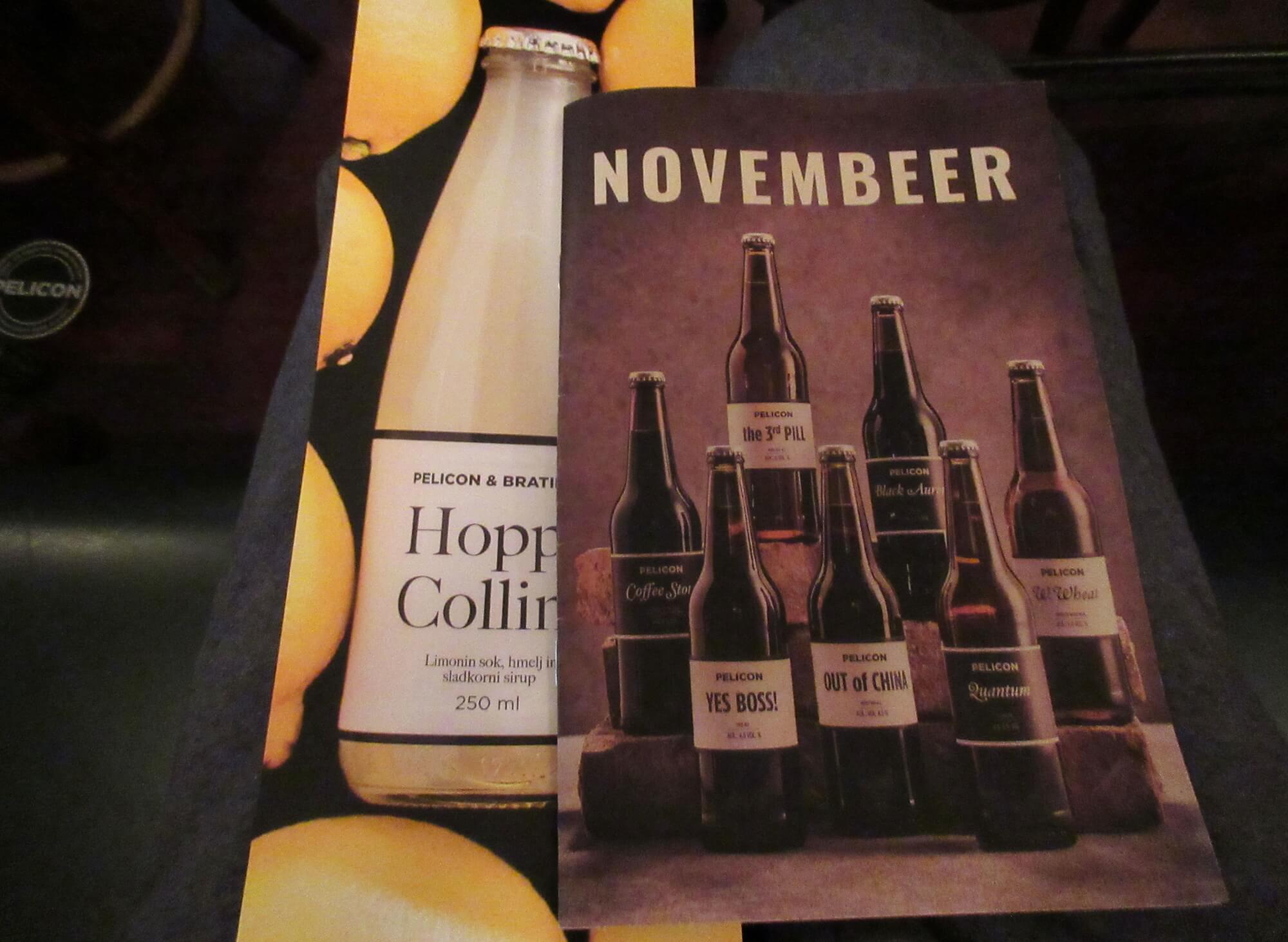
Photo: JL Flanner
Founded in 2013, Pelicon’s already one of the old names on the Slovenian craft beer, making a splash with its early IPAs, distinctive, black and white packaging and often names – Out of China is a play of Ajdovščina, The Third Pill is a Žižek reference, W. Wheat is Breaking Bad, and so on. For this promotion there are two new beers and three variations on old favourites. The first of the new brews is a 6% IPL – or Indian Pale Lager – while the second is Harvest Moon 2019 (5.4%). The promotion also includes some already well-loved beers that are well suited to colder days and longer nights: Black Aurora (a porter, 6.2%), Quantum (a double IPA, 8%), Veliki IPA (a 10% IPA – you have been warned), Coffee Stout (made with real coffee and 8%), and Winter Warmer (a traditional end-of-year beer, with 8.4% of added warmth).
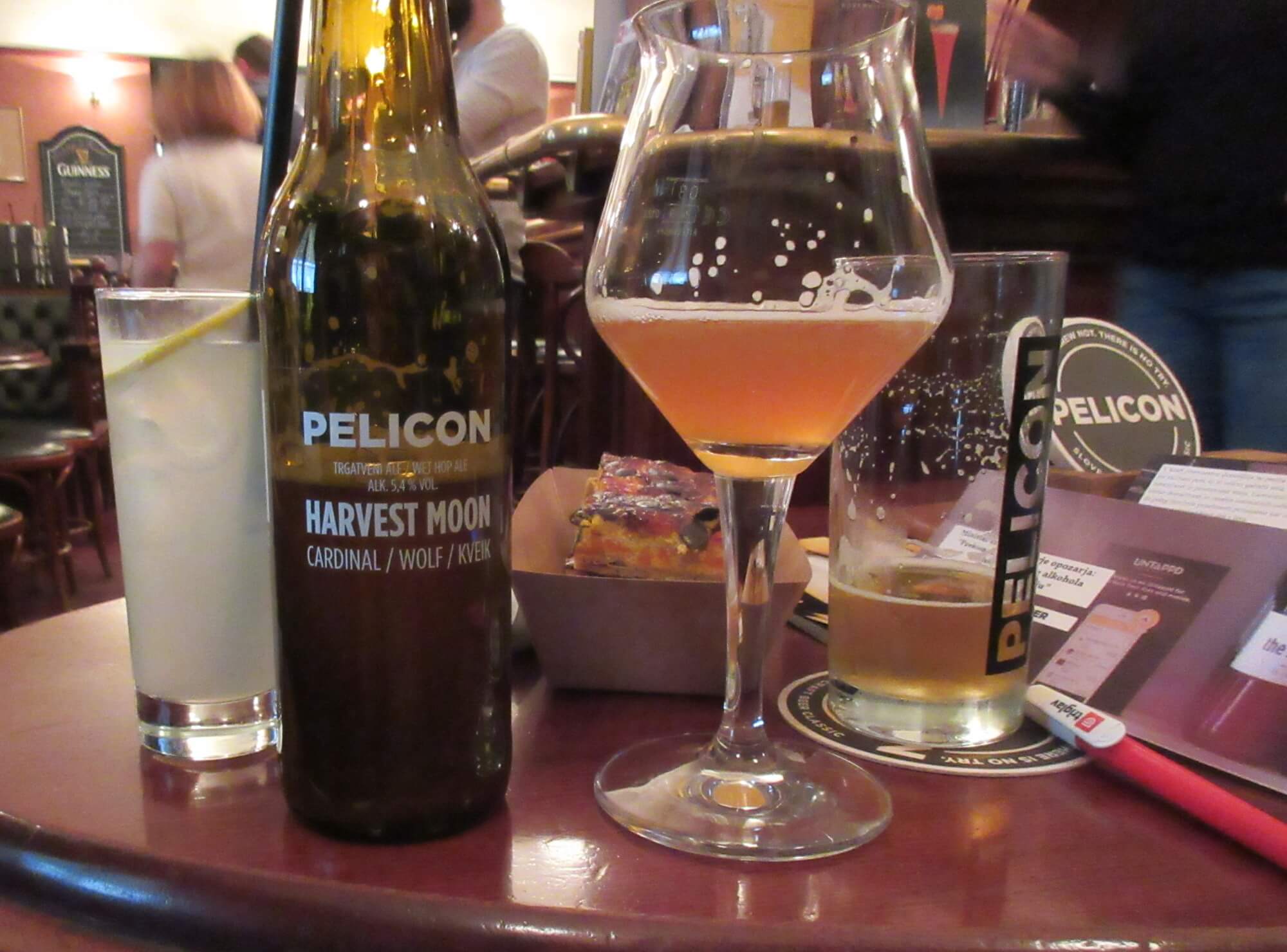
Photo: JL Flanner
While some of these beers can be purchased in bottles, most are making their current appearances on tap. In Ljubljana you can find them at Sir Williams Pub, Dobra poteza - the boardgame café, Patrick's Irish Pub, and Pop's Place. In Maribor you can explore the new beers at Isabella food&wine, while in Ajdovščina you should head to Bar Hiša Mladih.
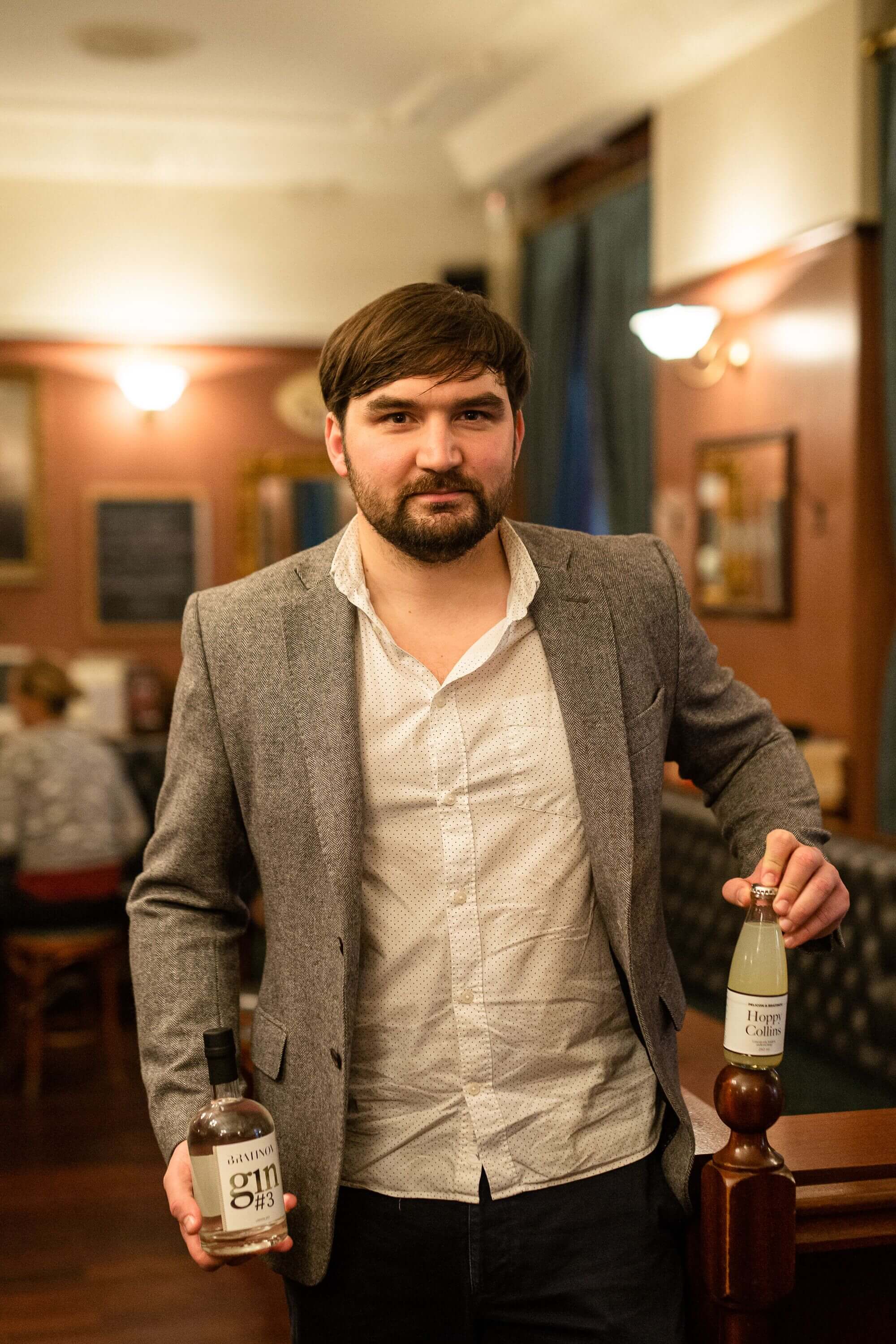
Miha Bratina of Bratinov Gin. Photo: Jan Čermelj
Still, not everyone drinks beer, or alcohol, and thus Pelicon is also launching its collaboration with Bratinov Gin, the Hoppy Collins lemonade. This is a fresh, high quality Slovenian mixer, nad one that you can expect to see at in more and more bars over the festive season.
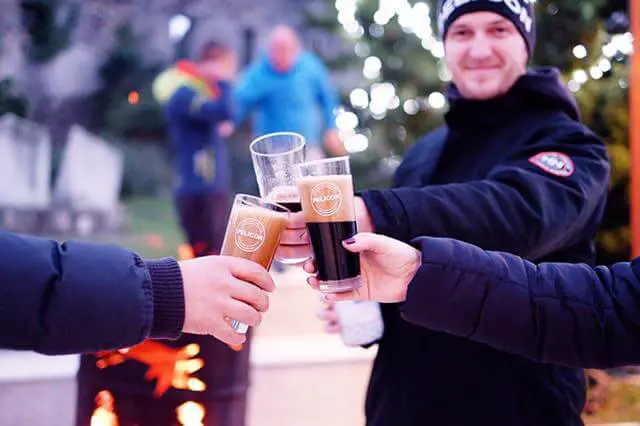
Photo: Pelicon
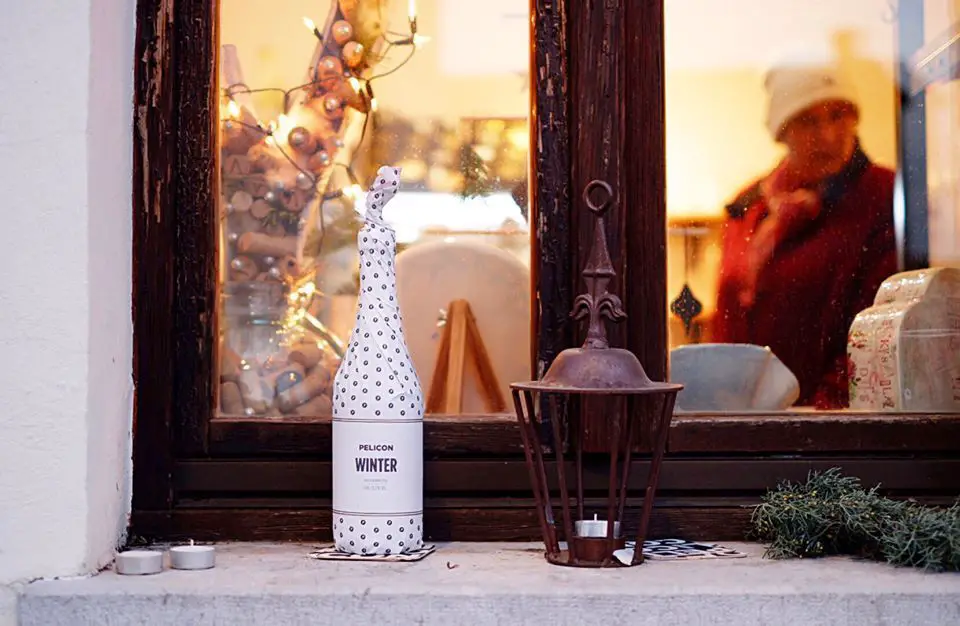
Photo: Pelicon
Up next for Pelicon is another of its international collaborations, this one with the Yeastie Boys team from the UK, as the brewer continues to help spread the word on Slovenian craft beer and share ideas with the best and most interesting brewers around the world.
The Slovenian gin scene is booming, helped along by the country’s long history of distillation and production of juniper-based schnapps (brinjevec or brinavec), as well as it’s growing reputation as a culinary destination.
One of the dozen or so gin producers that started business in recent years is Broken Bones, with a name that comes from when the owners, Borut and Boštjan, both had accidents when working with their first whisky barrels, resulting in a broken leg and broken nose.
I’d briefly met Boštjan at various gin-related events around town, but curious to know more about the first gin maker in Ljubljana, and the first new distillery in the capital in some 50 years, I decided to visit the place myself, an experience that’s now open to all.
It’s a short drive or cycle from the centre of town, at 132 Tršaska cesta, just between a Toyota showroom and a Petrol station. Since there are samples on offer you might prefer to get a bus, with both 6 and 6b taking you there from Slovenska cesta.
From the outside it’s easy to miss. Photo: JL Flanner
It's a small place, divided into a clean, white tiled distillery and a wood and leather showroom / store / bar. Playing the background is a sound collage of distillery sounds, put together by a DJ Boštjan knows from his time when he and the legendary Umek helped kickstart the techno scene in Slovenia, releasing records putting on club nights at Nexus and K4, two or three lifetimes ago.
Photo: JL Flanner
What’s your background?
Computer programming, a very different business. I worked in that for years on various projects. For example, I started the bolha.com, the online market, before eventually selling that, and then there was Napovednik. I was still working on that until recently, in fact, but Broken Bones (BB) was taking up more of my time, so now this is it.
How did you and Borut get into distilling?
It was a long process. I’m a technical guy, and my wife’s family has a vineyard, so I’ve been working with wine, thinking about wine for over 20 years. I also got into making beer, and was interested in whisky, starting from about eight years ago. But these were hobbies, not businesses.
At the same time my partner in Broken Bones, Borut, had been importing whisky in Slovenia since 1991, when the country became independent and that kind of business was possible. He also has a family history of distilling, so that was a hobby of his. He was making schnapps, and then he started making absinthe, one of the first producers in Slovenia.
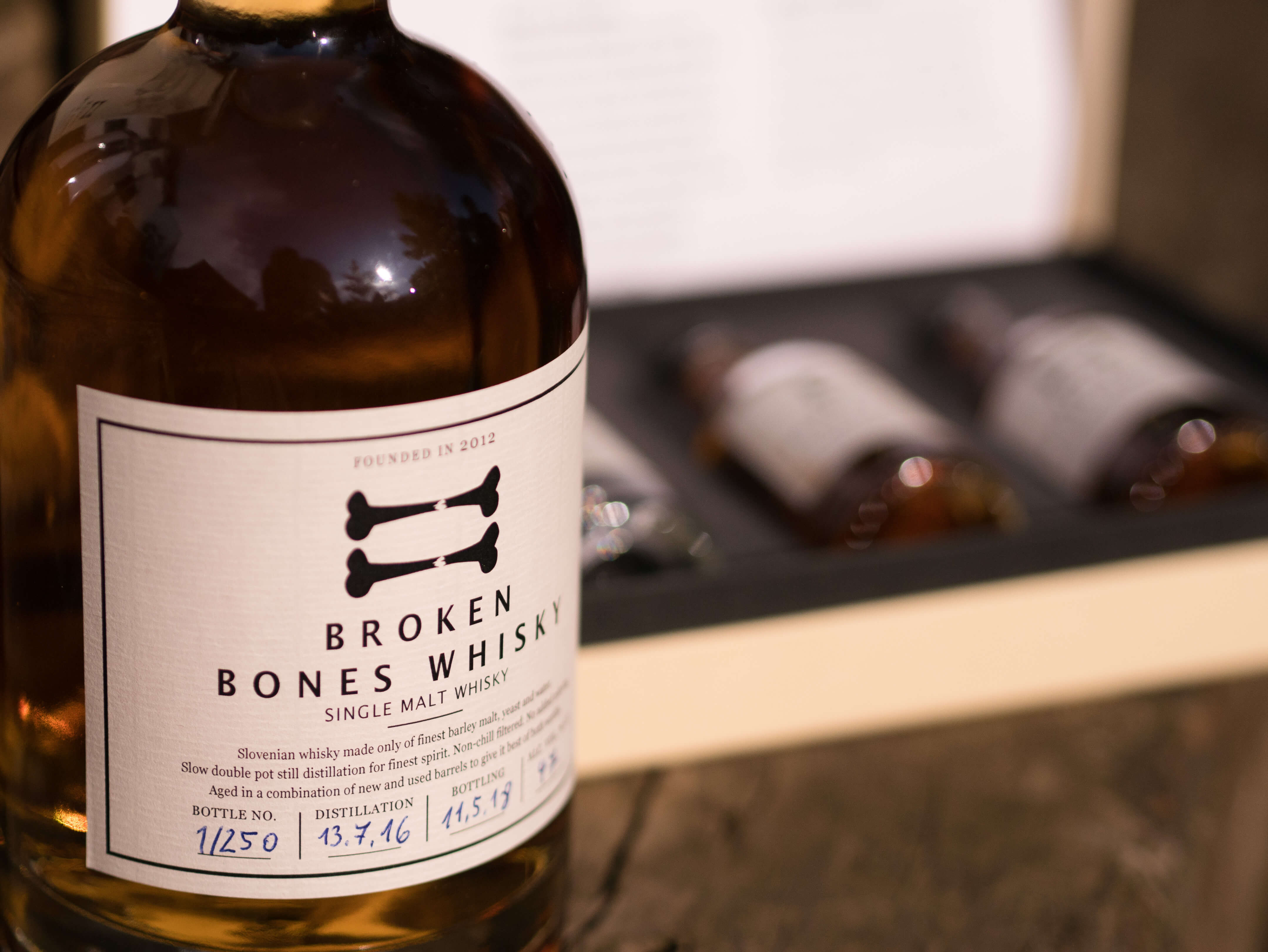
Broken Bones still makes small batches of whisky
So when we started working together it was in my basement in Kodeljevo, and we made our own still, for whisky, soldering the parts together ourselves, one that we still use here.
But whisky takes a long time, and it can be a very long time aging in barrels before you get a good whisky, because the raw whisky – the new make, the colourless liquid that comes out of the still, is really not something anybody would like to drink. Gin, on the other hand, is a lot faster to produce, with no real aging. It just needs to rest for a month or so and it’s ready to drink, so from a production point of view it’s a lot more appealing. We knew that many small whisky distillers were making gin precisely because of that, but not really liking classical gins we were not interested in making them. This changed a couple of years ago when we discovered the modern styles of gin by going to whisky events in London, where we learned about modern, much more interesting and aromatic gin, the kind from, say, Bombay Sapphire onwards, and that really started us thinking, especially because Slovenia is well known for its juniper berries.
We started experimenting with gin. Did about a hundred distillations on a small scale, studying a lot of the literature and using the knowledge we already gained through working with whisky. We experimented with botanicals, their ratios and different still designs. It took us about a year to get to the recipe we really liked.
The distillery is open for small groups, where you can sample the drinks along with some appropriate snacks
How long has Broken Bones been open?
Since May 2018, and we were very lucky when we launched. It was just when the gin craze was getting started here, with more producers, more bars and events.
I have to say that the craft beer scene really helped in this, too. Before then people were just drinking local lager, not thinking much about anything else but price. Then with craft beer things became more like wine. People were interested in what’s new, what’s next, and they also understood that you have to pay more for quality. So when people started making craft gin in Slovenia there was an understanding that this could be an interesting product, that it was worth exploring, and when you found something you really liked also that it was something worth paying for.

What’s the response been like?
Very good, both here and abroad. I’ve been going to London quite a lot, showing our gins to various bars, and we have a distributor in the UK now, as well as several awards. We currently have a 600 litre still, more than we need, but the way the business is growing it may be too small soon.
What ingredients do you use, and how are the London and Navy gins different?
We start off with a neutral alcohol, made of molasses, although grain is more common in the industry. For the botanicals we use the same in both our London Dry and Navy gins. Of course there’s juniper berries, but also lemon and cardamom, among other things, and then, as a Slovenian element, rosehip and linden. The Navy gin is stronger, with more alcohol, and that is why it can also carry more flavour it also has more botanicals.
We’re very busy at the moment, we only moved into this site at the start of May, but as things are settling down we should be able to launch something new soon, Old Tom Gin, with added linden tree flower honey and matured in Slovenian oak casks. Then we have a few more things we’re planning, including one that’s a more distinctive, Ljubljana gin, but that’s for another day.
And where can people find you?
You can find our gin at various bars and stores in Slovenia and the UK, but if you’re in Ljubljana then perhaps the best place is our distillery shop or the Central Market. Monday to Saturday, the part by the arcades that connects the two squares. Here you’ll find a stall where you can sample the gin. If you’d like a fuller measure, perhaps with a mixer, then the nearby Magda bar will do you. Elsewhere in town we’ve been working closely with Pritljičje and Kolribi, and if you’re looking for something a little different then Sveti Florijan, in the Old Town, makes a gin dessert.
People can also come here, for the Broken Bones Experience. We didn’t just want to do a classical tour of the distillery as such, although you obviously see it as well. But if you make a visit then you’ll learn about the history of gin, the process of distillation, the different kinds of gin, and, of most importantly, you’ll get to sample some, including in several cocktails from the selection of recipes created by Tina Pirnat especially for our gin accompanied with snacks, and try our gin pralines.
You can see the cocktail recipes here, with the one I tried below, while you can learn more about the Broken Bones Experience here.
The Martini Espresso with a Gin Twist
Ingredients:
- Broken Bones Gin - 30 ml
- Kahlua - 30 ml
- Espresso coffee - 30 ml
- Simple syrup - half a teaspoon
Preparation
- Shake and strain
With its long history of growing juniper berries (brina) and distilling a juniper-based schnapps (brinjevec or brinavec), Slovenia has the culture and skills needed to produce high quality gin. However, it’s only in recent years that commercial production of the spirit seems to have gained traction, with at least 14 distillers now having versions of the classic drink on the market.
We thus present part two of our series on Slovenian gin, to help you choose the next bottle or glass to enjoy.
Aufbix is a small-batch London-style gin flavoured with juniper berries, coriander, cardamom, carob, angelica and orris root, with additional citrus notes given to the spirit with the use of fresh peel from pink grapefruits and blood oranges from Sicily. And that Italian note isn’t the only international ingredient in the Aufbix story, as one of the founders of 78 Stopinj, the distillery that uses water from Mount Pohorje to produce it’s drinks, is from New Zealand, with a background in winemaking. Website.
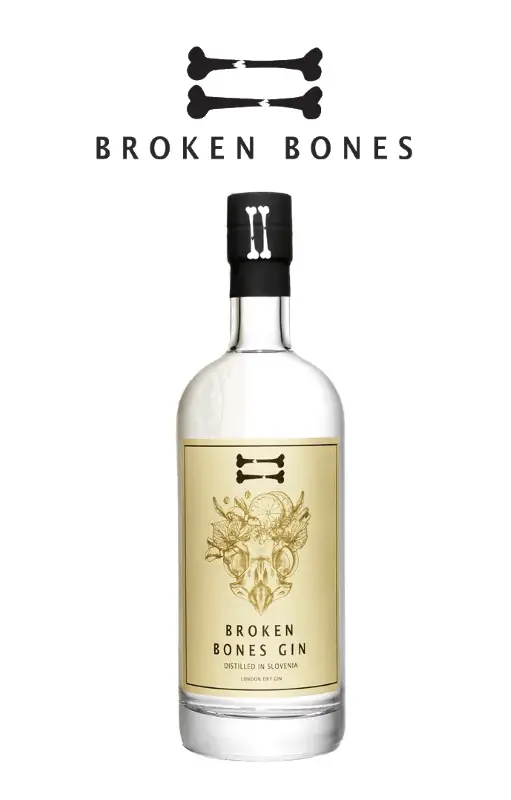
Broken Bones is made in Ljubljana from a distillery that started with whisky before moving on to gin, with the aim of producing a spirit that could be enjoyed neat as well as in a cocktail. The unique flavour of the drink is given by the use of rosehip berries and linden tree flowers, with the latter an especially Slovenian touch, given that this is one of the symbols of the nation. The name comes from when the owners, Borut and Boštjan, both had accidents when working with their first whisky barrels, resulting in a broken leg and broken nose. The gin is made in small batches, with each batch being slightly different. In addition to the standard gin, the company also produces Broken Bones Navy Strength Gin (57% ABV), and is working on Broken Bones Old Tom Gin, with added honey and matured in Slovenian oak casks. Website.
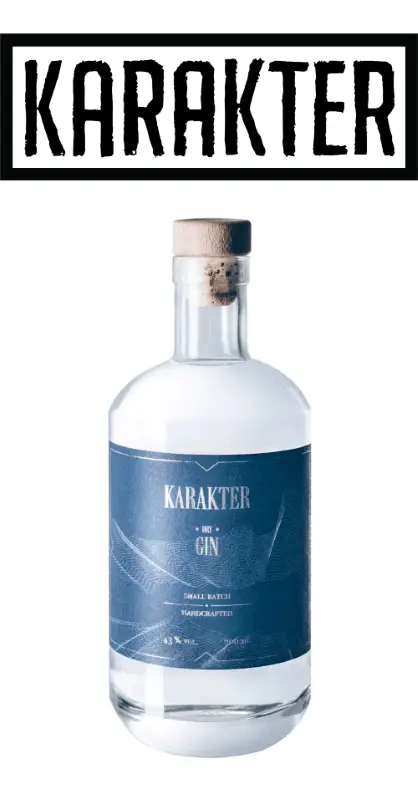
Karakter Gin is distilled by a team who were draw to the spirit for two reasons: first for the relative simplicity of it’s production, and second because gin is a drink that allows for a wide range of experimentation. The result is thus a gin that has character, hence the name, and one that seeks to explore the basic idea of gin by brining out the complexity of the usual juniper berries and botanicals by adding various atypital herbs and spices. If that sounds intriguing then seek out a bottle or glass of Karakter Dry Gin, produced using maceration, infusion, and percolation. Website.
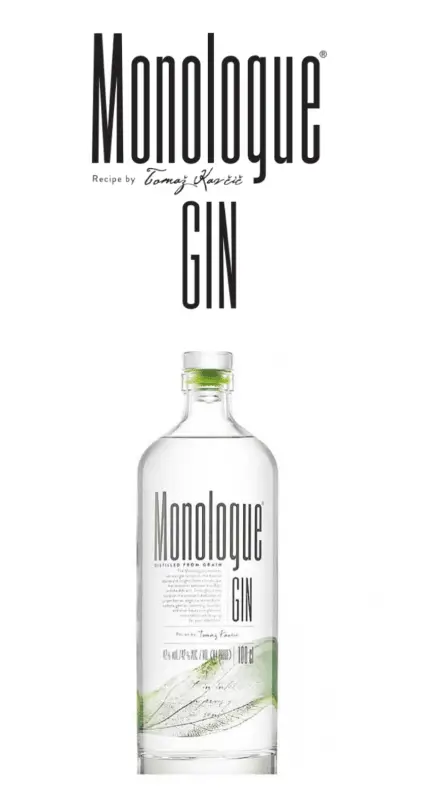
Monologue Gin is the first “celebrity” gin in this series, presented by Tomaž Kavčič, the top chef of the famed Pri Lojzetu. The twist on this gin is that Kavčič has aimed to capture the taste of Vipava in the spirit, which in addioion to the usual herbs and botanicals is flavoured with rosemary, lavender and an extract of olive leaves. No website at present, but the restaurant can be found here.
Other articles in this series can be found here
If you enjoy gin then what better way to turn your habit into a hobby than to explore the world beyond the big names, and if you’d like a good excuse to restock your liquor shelf with intriguing bottles and varied tastes then consider entering the world of Slovenian gin
To the ill-informed this might seem like a risky proposal – what would Slovenians know about gin? But this would be a mistake akin to dismissing Japanese whisky or Californian wine. More so, perhaps, as Slovenia not only has the climate and knowledge needed to produce the drink, but a long history of working with juniper berries, producing a native spirit known as brinjevec (sometimes brinavec).
Brina is the Slovenian name for the berry that gives gin, along with various other botanicals – each producer using their own selection – its distinctive taste, and here we’ll note that botanicals, distillation and restorative liqueurs are also all part of the country’s cultural heritage. And gin, if not quite in the DNA, is certainly in the bloodstream of a growing number of Slovenians.
We thus present part one of a brief guide to of the bigger names in domestic gin production, the ones you might find in good liquor stores and bars across the country, and soon, perhaps, abroad.

Berryshka, based in Dolenjske Toplice, is family firm that started in 1950 producing essential oils. While this remains the core business, the company has long applied its expertise in extraction and distillation to other products, including a range of spirits and fruit liqueurs, with drinks that are low in sugar, come with no artificial colours or additives, and are made using natural spring water. These liqueurs are based on natural flavours such as cherry, aronia, walnut, blackcurrant, blackberry, blueberry, and juniper – the berry that gives gin its distinctive taste. Berryshka juniper products currently include a brinjevec – marketed as brandy and sold in both original and oak-barrel aged varieties – and two gins. London Gin Berryshka follows the traditions of the most popular gin, with a neutral alcohol flavoured with juniper berries, angelica, iris, cinnamon, liquorice, cardamom, anise, cumin, lemon, and coriander, while the while the more distinctive BrinGin Berryshka has the alcohol provided by juniper distillate, producing a drink that can be savoured neat, or enjoyed with the usual mixers. You can find Berryshka’s liquers and chocolates in many stores, but for the full experience you’re welcome to visit the factory, which also produces handmade chocolates, an experience that could easily be combined with a trip to Novo mesto, or the nearby hot springs. Find out more the company’s website.

Brin Gin is the work of Erik Sarkič, a third-generation brinjevec producer who grew up with a deep background in junipers and distillation. The move to gin was thus natural one, opening up new markets for the family business, and arguably making better use of the berries, since a litre of brinjevec requires around 8 kg of them, while the same amount of gin gains it’s more subtle flavour from just 20 g. In his mission to dive deeper into the flavour profile of the juniper Berry Erik is supported by Matevž Kmet, a biochemist who works as a consultant for the firm and has the air of a mad scientist, or at least a man for whom the greater the challenge, the more exciting it is to consider. Together Erik and Matevž dream up new products and then work to make their dreams become reality. One of these, still in the experimental stage, includes an alcohol-free gin, for those who love the taste of a good G&T but want to maintain a clear head. Another is what’s intended to be the world’s best, and most expensive, gin – with production of this now completed, and the launch only waiting on the perfect bottle to be found. Finally, Erik and Matevž are also working on a product that will be made entirely of juniper, including a juniper wood bottle. You can keep up with the latest developments, and order a bottle online, here.

DTG (Dry Tergeste Gin) also takes its own approach to the classic spirit, and is yet another small producer showing that the Slovenian tradition of brinjevec means the country is well positioned to become home to a variety of boutique gin brands, all of which are worthy of a place on your shelf. The name refers to Tergeste, or Trst (or, you must, Trieste), and Martin Žužek Kres, an anthropologist by training who developed the drink, wants his products to reflect the history of the land. However, DTG doesn’t just have a story to tell, but also a product that distinguishes itself from other gins in a number of ways. For one, it avoids the use of grain alcohol to give the drink its kick, and instead relies on alcohol produced from the juniper berry, mixed with a unique coffee cherry brandy. Coffee cherries are the fruit that grow around and protect coffee beans, and contain both caffeine and antioxidants. Their use in gin doesn’t produce a coffee-flavoured drink, but does give an interesting taste that can be enjoyed neat, without ice, or with mixers. In a sign of how quickly the Slovenian gin scene is set to evolve, the company has three new products that are still in development, but which I was lucky enough to taste at a recent event, and these will add to the flagship drink’s flavour profile with the use of spruce, thyme, and wild mint. Look out for DTG in stores, or order a bottle online.
All the parts of this series can be found here


